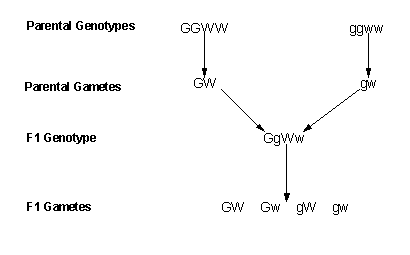Introduction
Mendel provided his knowledge concerning reproduction mechanically during his period. The independent Law of assortment provides that off springs inherit traits from their parents. This is related to genes, DNA and chromosomes. In this context, genes of parents determine the traits of an off spring.
These genes are located on the chromosomes while chromosomes are made up of DNA molecules. Each parent donates a pair of genes to the off spring during mating whereby, males have (XY) while female contain (XX) chromosomes (Campbell & Reece 56). The two genes do not blend but one of them dominates over the other.
Thus, it helps in determining the gender of the off spring. This gives the impression that the off spring can either be a female or a male. This paper will give an extensive explanation of the Mendel’s law of independent assortment.
Mendel’s law
Independent assortment law describes how different genes separate from one another during development of reproductive cells. Gregor Mendel observed that the first corresponding traits of the assortment law in 1865. He carried out dihybrid crosses between animals that differ in traits. He realized that parental blend of traits is different with that of the young ones.
Mendel carried out crosses after separating the two genes. This basis enabled him to come up with his second law, which is “The Law of Independent Assortment.”
Some of the important terms in Mendel’s second Law of Assortment are explained below;
Dihybrid cross is a breed between two parents who differ in two allele pairs (AABB*aabb). On the other hand, a dihybrid is an individual who is heterozygous for two allele pairs (AaBb). In this context a dehybrid cross does not mean a cross between two dihybrids (Campbell & Reece 70).
Mendel’s dehybrid cross
Parental cross: a yellow round seed * a Green, wrinkled seed, in the F1 generation all the off springs are Yellow in color and round in shape (YR). The F2 generation produces 9 Yellow and round off springs, 3 yellow and wrinkled off springs, 3 Green and round off springs, together with one green and wrinkled off spring (McClean 78).
This gives the project the following symbols seed color= Yellow for Y and green for G. For the seed shape round will be represented by R while wrinkled will be represented by W.
The purpose of dihybrid cross is to determine if there is any relationship between different pairs of alleles.
The diagram below shows Dihybrid Cross using the above symbols

Now set up the Punnett Square for the F2 cross.
The general genotypes and phenotypes can be represented as follows:
Using the results to formulate Mendel’s second Law
Second law of Mendel: Independent assortment law states that during the formation of gametes segregation of one pair alleles is independent from segregation of another pair of alleles. Using monohybrid cross confirmation of the second law can be done through performing a backward cross. (F1 dehybrid *recessive parent). The diagram below shows an example of a backward cross to confirm the second law of Mendel using Yellow, round seeds F1 (McClean 90).

The Punnet Square of the backward cross
The following shows the phenotypic ratios of the test cross;
1 yellow, round seed
1 yellow, Wrinkled seed
1 Green, round seed
1 Green, Wrinkled seed
Works Cited
Campbell, Neil & Reece, Jane. “14″, Biology (Sixth ed.). New York: Benjamin Cummings, 2011. Print.
McClean, Philip. Variations to Mendel’s First Law of Genetics. Pearson: Prentice Hall, 2005. Print.